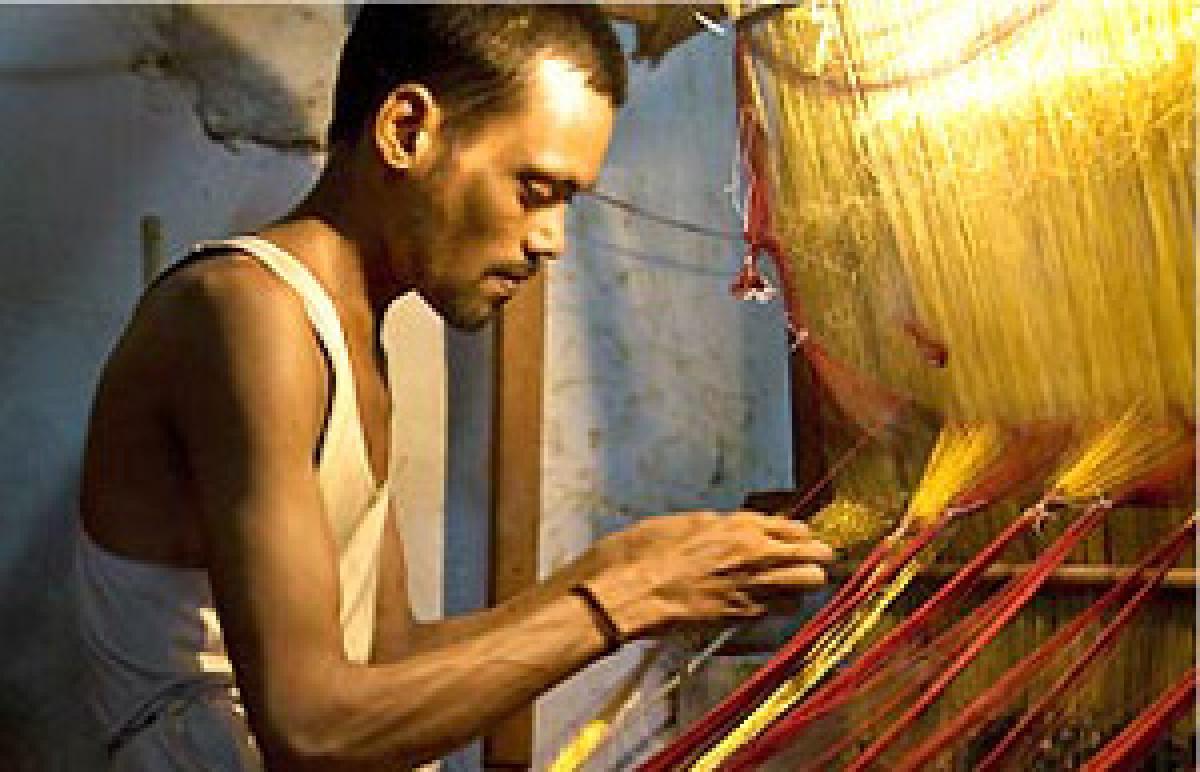Live
- Dhankhar a govt spokesperson, biggest RS disruptor: Kharge
- Fire breaks out at petrol pump
- Facial recognition-based attendance in Sectt from today
- TGPSC to be restructured on par with UPSC
- Gabba pitch to have pace and bounce
- Not taking a break after Olympics left me emotionally drained
- SSC public exams from March 17 to 31
- Pathetic state of Zoo Park-Aramghar underpass turning deadly for commuters
- Losses galore for PCB if it pulls out of Champions Trophy over hosting deadlock
- Govt to support plot owners in build homes
Just In

A hand-to-mouth existence. History of industrialisation in India was determined by political conflicts and contradictions rather than technological diffusion and innovation alone. Pandit Deendayal Upadhyaya’s philosophy gelled with that of Mahatma Gandhi and many others in emphasising upon local production and consumption.
 TODAY IS NATIONAL HANDLOOM DAY
TODAY IS NATIONAL HANDLOOM DAY
Over a 19-year period, the handloom sector has not received adequate allocations. There is no continuity in schemes. Implementation has been shoddy and expenditure is low. There is no proper need assessment for handloom sector. Besides, the draft National Fibre Policy is poised to deal a body blow to the handloom sector. This policy recommends encouragement of man-made fibres. This would increase the costs of natural-fibre based textile products, in comparison with man-made fibre products, essentially killing all the small-scale production
History of industrialisation in India was determined by political conflicts and contradictions rather than technological diffusion and innovation alone. Pandit Deendayal Upadhyaya’s philosophy gelled with that of Mahatma Gandhi and many others in emphasising upon local production and consumption.
Continuation of handloom weaver livelihoods, even as it vanished in many countries, fits completely into the modern philosophy of production. The NDA government’s Make-in-India programme easily assimilates Pandit Upadhyaya’s thought process, which encourages India-based production of goods and services.
Congress failed the handloom sector in its ten years of rule. The present government had to bring about a lot of policy changes to serve the core purpose of declaring 7th August as the National Handloom Day. To begin with, Arun Jaitley’s second budget (2015-16) did not provide enough allocations.
Instead of increasing, budget for handloom weavers was slashed by almost Rs 118 crore. With more than 1 crore employed in handloom sector, a paltry Rs 446.6 crore outlay does not help – there has been 21 per cent cut in the outlay. Per capita spending of the government on handloom sector does not exceed Rs 500.
Thousands of handloom weavers are becoming poorer by the day, as their wages are not increasing. Handloom weavers are in need of low interest credit. At present, they are borrowing money at exorbitant interest rates, ranging from 14 to 60 per cent. Debt burden on individual handloom weavers is a major problem.
Cost of living has increased in the last 15 years steadily, and tremendously over the last few years, generously aided by inflation and under regulation of basic food commodity prices. Cost of raw material, especially cotton and silk yarn have also gone up. With competition from cheap and fake handloom products, handloom weavers can’t raise their incomes to respond to rising costs of living and raw material prices.
Further, the most critical component of their production, working capital flows are drying up. NABARD has drastically reduced its exposure. Lack of awareness, exploitative conditions compound the misery caused by high interest rates. From allocations to actual disbursement, the entire route of government doles has failed handloom sector and handloom weavers. In 2013-14, a paltry Rs 157 crores was allocated.
Expenditure in the same year exceeded this allocation, reaching Rs 269.79 crore. In 2014-15, no allocation was done for this critical support. This year, in 2015-16, the government seems to have completely forgotten the needs of the handloom weavers. For the past few years, governments have been reducing the number of schemes in handloom sector.
From 12 schemes, they were reduced to four (2014-15) and 3 (2015-16). Comparatively, allocations for other sub-segments of Indian textile industry which is automated, modernized, mechanized, is fully getting the attention of government budget allocations.
Over a 19-year period, the handloom sector did not receive adequate allocations. Allocations for handloom sector have been fluctuating. There is no continuity in schemes. Implementation has been shoddy. Expenditure is low, even though the allocations are pittance. There is no proper need assessment for handloom sector.
Handloom funds are being soaked up by institutions, employees, corruption, bad planning and low commitment. The draft National Fibre Policy is poised to give another blow to the handloom sector. This policy recommends encouragement of man-made fibres.This would increase the costs of natural-fibre based textile products, in comparison with man-made fibre products, essentially killing all the small-scale production.
Any industry, the world over, requires public policy support. Handloom sector is no exception. While it is true that handloom sector is major source of employment, one cannot ignore the fact that it is also an industry. The strength of the handloom sector is its large and skilled labour.
This is also the strength of the Indian textile sector. One needs to enhance this strength and address factors that weaken this strength. Modern economists should keep in mind the fundamental economic principle: maximum good for the maximum people. (The writer is a textile policy analyst)
By Dr D Narasimha Reddy

© 2024 Hyderabad Media House Limited/The Hans India. All rights reserved. Powered by hocalwire.com







